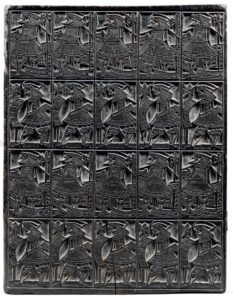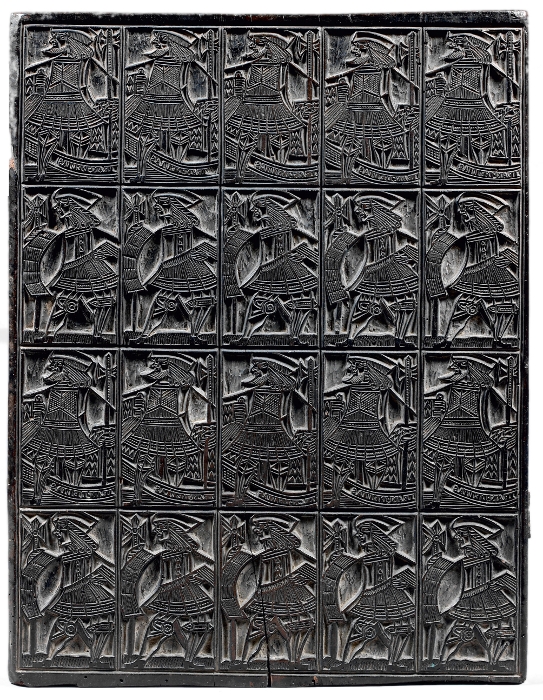PLAYING CARDS. Board of printing for 20 jacks. Nérac, Jean Délias, between 1720 and 1751. Board of printing in engraved wood representing 20 jacks. Small vertical split on one of the cards. Dimensions of the board: 398 x 310 mm. (Thickness: 2 cm). Each card measures 57 x 92 mm. Exceptional board of printing of playing cards executed in Nerac between 1720 and 1751. This engraved wood bears the figures of 20 jacks, 10 of them being signed by Jean Délias. Délias father and son are known as card makers in the town of Nérac at the end of the 17th century and at the beginning of the 18th century. Their production is inspired from the one of Bordeaux.
« In France, the oldest woods contained the engraving of twenty cards, and in order to have the necessary figures to form a pack of cards, the card makers owned two distinct moulds. On the first one were engraved the jacks of the red series, that is to say that it comprised 10 jacks of diamond, and ten jacks of heart, while on the other one there were the kings, the queens of two packs as well as the four black jacks necessary to complete the quadrille. As for the points, they were simply stencilled. » (D’Allemagne, Les cartes à jouer du 14e au 20e siècle, p. 391)
This engraved wood corresponds to the mould of jacks of the red series; it comprises 10 jacks of diamond and 10 jacks of heart. The two jacks appearing on this wood are reproduced page 126 of the Cartes à jouer by D’Allemagne.
« During the retaxation of the right upon cards, in 1701, the farmer, in order to suppress as much as possible the frauds committed, and also to obtain a more perfect tax received, forced the card makers to use identical moulds in each region. For that reason, France was divided in nine sections, each of them having their own pattern. These nine patterns that were competing with each others in front of the players of our country were the following ones: the ones from Paris, Burgundy, Lyons, Auvergne, Dauphiné, Provence, Languedoc, Guyenne and Limousin. »
The cards with Guyenne’s portrait (from Aquitaine) presented here are recognizable by a few characteristics. « The jacks from Bordeaux are characterized by the enormous width of their sleeves, especially for the red jacks. It is quite difficult to prescribe a precise rule concerning the attributes worn by the different characters because at each change of mould the farmers and after them the agents, in the second part of the eighteenth century, added slight changes: these modifications were made to prevent the card makers from trafficking with the help of the old moulds… The pattern from Bordeaux was also chosen by the card makers from Montauban who published it, but very reduced, as their cards were printed with moulds of thirty cards a leaf, while in Bordeaux and Agen they were printed by twenty cards ».
This kind of testimony of the printing techniques of the beginning of the 18th century is extremely rare on the market.
A precious engraved wood of playing cards from the beginning of the 18th century, in an exceptional preservation condition.
See less information


